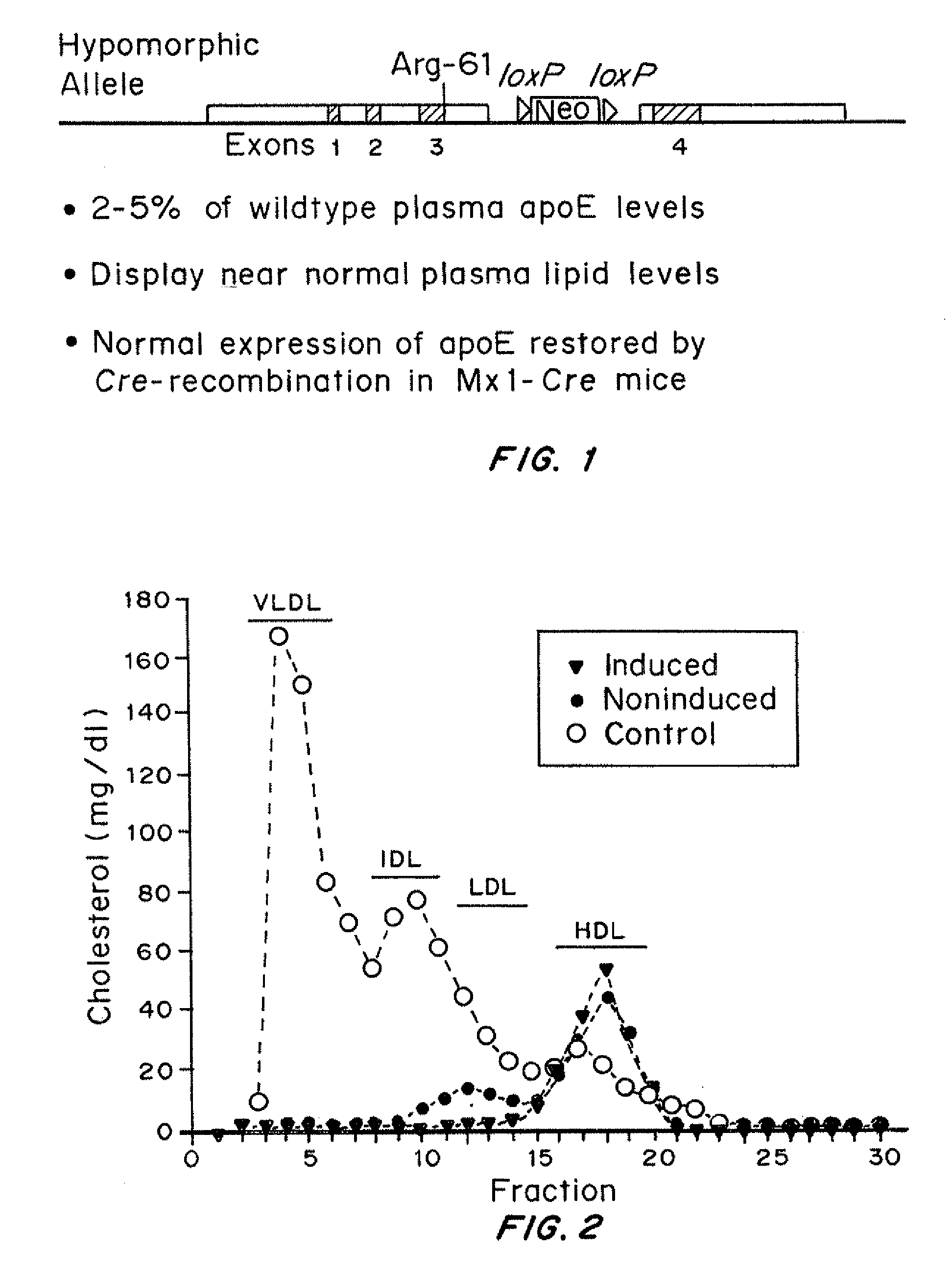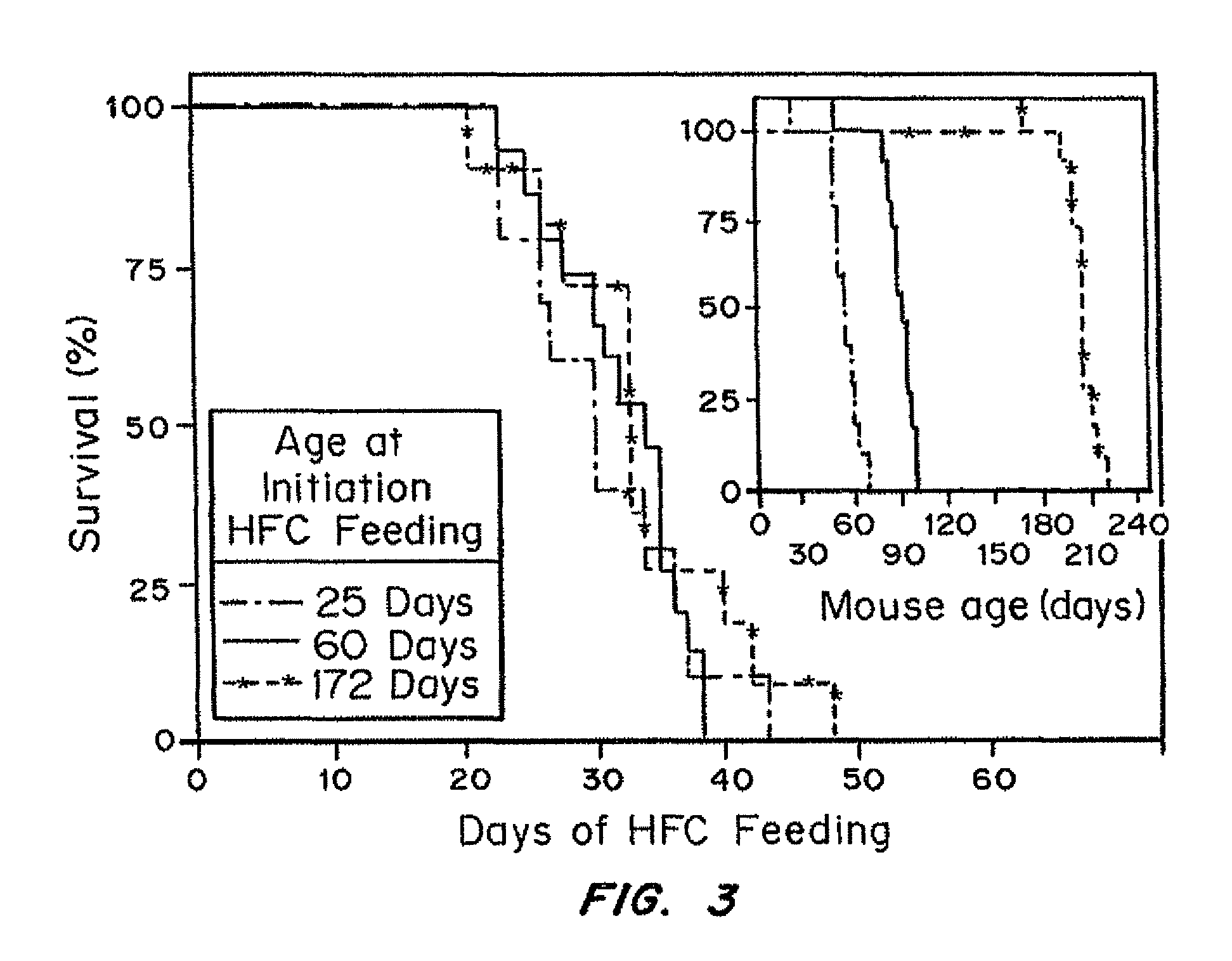Mouse model of chronic heart failure and coronary atherosclerosis regression
a heart failure and chronic heart disease technology, applied in the field of transgenic animal models, can solve the problems of increasing the inability to deliver an adequate amount of blood to the heart muscle, and the risk of coronary heart disease and heart failure, so as to accelerate the coronary atherosclerosis regression disorders and reduce life span
- Summary
- Abstract
- Description
- Claims
- Application Information
AI Technical Summary
Benefits of technology
Problems solved by technology
Method used
Image
Examples
example 1
Production and Characterization of Combination Transgenic Animals Which do not Express SR-BI and have Reduced ApoE Expression (Apoeh / h)
[0061]Generation of Apoeh / hSRB1− / − Mutant mice.
[0062]Apoeh / hSRB1− / − mice were generated by crossbreeding established SR-BI knockout mice with hypoE mice. Homozygous SR-BI knockout dams are infertile (Miettinen et al. (2001) J Clin Invest. 108(11):1717-22; Rigotti et al (2003) Endocr Rev. 24(3):357-87). It is therefore necessary to use an SR-BI knockout male crossing with a hypoE dam while also accounting for the infertility of female mice during crossbreeding. Alternatively, the cholesterol lowering drug probucol has been shown to restore fertility in the SR-BI knockout females and may be administered during the breeding protocol (Miettinen et al. 2001).
[0063]Characterization of Plasma Lipids and Apolipoproteins
[0064]Plasma lipids and apolipoproteins were assayed for wild type and Apoeh / hSRB1− / − mice and compared with hypoE, SR-BI− / − and ApoE− / − sing...
example 2
Manipulation of the Progress of CHD by Feeding Mice Which do not Express SR-BI and Have Reduced ApoE Expression (Apoeh / h) Different High Fat Diets
[0074]Apoeh / hSRB1− / − mice were generated as described in Example 1. 5 Apoeh / hSRB1− / − mice were fed a normal low fat chow diet, a high fat (HF) diet consisting of 7.5% cocoa butter, 15.8% fat, 1.25% cholesterol, and 0.5% sodium cholate, a NCA diet consisting of 7.5% cocoa butter, 15.8% fat, and 1.25% cholesterol, or a Western Diet (WD) diet consisting of 21.2% fat, and 0.2% total cholesterol.
[0075]Plasma lipids and apolipoproteins were assayed for Apoeh / hSRB1− / − mice when fed a normal low fat, low cholesterol diet, the HF diet, the NCA diet, or the WD diet. These data are summarized in Table 5.
[0076]
TABLE 5Plasma lipid and apolipoprotein levels of SR-BI / hypo E mice on different high fat diets.RatioDietTCUCPLTGUC / TCUC + PLNormal1010 ± 237 817 ± 188686 ± 93 42 ± 180.811 ± 0.0326.63 ± 1.7(n = 19)HF diet6630 ± 337 1,284 ± 274 976 ± 25372 ± 130....
example 6
Production and Characterization of Combination Transgenic Animals Which do not Express the SR-B1 Gene, have Reduced ApoE Expression and Express the Inducible Mx-1-Cre Transgene (Apoeh / hSRB1− / − Mx1-Cre Mice)
[0080]Generation of a Hypomorphic Allele of Apoe—A sequence replacement gene-targeting strategy was previously used to substitute arginine for the mouse equivalent of human Thr-61 as described by Raffai, et al. Proc. Natl. Acad. Sci. U.S.A. 98, 11587-11591 (2001). In creating an allelic variant of mouse Apoe designed to resemble human apolipoprotein E4 (apoE4), hypomorphic apoE (hypoE) mice that express only ˜5% of normal apoE mRNA levels in all tissues were made by insertion of a neo cassette flanked by loxP sites in the third intron of Apoe. This reduced expression of the Arg-61 allelic variant in hypoE mice and resulted in plasma apoE levels that were ˜2-5% of normal.
[0081]Breeding Apoeneo+ / neo+ Mice Expressing a Cre Transgene—Apoeneo+ / neo+ mice were crossed with inducible Mx1-...
PUM
| Property | Measurement | Unit |
|---|---|---|
| survival time | aaaaa | aaaaa |
| blood pressure | aaaaa | aaaaa |
| electrical conductance | aaaaa | aaaaa |
Abstract
Description
Claims
Application Information
 Login to View More
Login to View More - R&D
- Intellectual Property
- Life Sciences
- Materials
- Tech Scout
- Unparalleled Data Quality
- Higher Quality Content
- 60% Fewer Hallucinations
Browse by: Latest US Patents, China's latest patents, Technical Efficacy Thesaurus, Application Domain, Technology Topic, Popular Technical Reports.
© 2025 PatSnap. All rights reserved.Legal|Privacy policy|Modern Slavery Act Transparency Statement|Sitemap|About US| Contact US: help@patsnap.com


